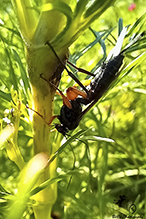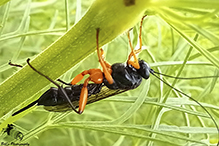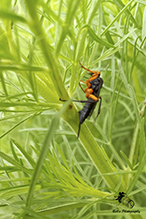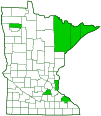Ichneumonid wasp
(Pimpla pedalis)
Conservation • Description • Habitat • Ecology • Distribution • Taxonomy
Conservation Status |
|
|||||||
| IUCN Red List | not listed |
|||||||
| NatureServe | NNR - Unranked |
|||||||
| Minnesota | not listed |
|||||||
Description |
||
Pimpla is a genus of ichneumonid wasps with a slender, entirely black body and orange legs. There are twenty species in North America north of Mexico, but only two species have been recorded in Minnesota. Pimpla pedalis is a medium-sized, black and orange ichneumonid wasp. It occurs throughout North America north of the 38th parallel, which extends from northern Virginia in the east to northern California in the west. Larvae are parasites of many species of moth caterpillars and sawfly larvae. The body is slender-waisted, entirely black, and shiny. The face is entirely black with no white markings. The antennae are not flattened. The inner margin of the compound eye is only weakly concave above the antenna base. The rear part of the body (gaster) is cylinder-shaped but depressed above. On the female, the ovipositor is stout, straight, and somewhat tapered, and it projects conspicuously beyond the tip of the gaster. On the hind legs, the tip of the third leg segment (femur), the fourth segment (tibia), and the last part of the leg, corresponding to the foot (tarsus), are black, but the legs are otherwise entirely orange. This feature distinguishes Pimpla pedalis from all other wasps in the genus. On the front legs the claw at the tip of the tarsus does not have a tooth-like lobe at the base. On the middle and hind legs there is a pair of thick spurs at the tip. There is a very small cell (areolet) in the middle of the forewing. |
||
Size |
||
|
||
Similar Species |
||
Habitat |
||
|
||
Ecology |
||
Season |
||
|
||
Behavior |
||
|
||
Life Cycle |
||
|
||
Larva Food |
||
|
||
Adult Food |
||
|
||
Distribution |
||||
|
Sources |
|||
| 10/15/2022 | ||||
Occurrence |
||||
|
||||
Taxonomy |
|||
Order |
Hymenoptera (Ants, Bees, Wasps, and Sawflies) | ||
Suborder |
Apocrita (Narrow-waisted Wasps, Ants, and Bees) | ||
Superfamily |
Ichneumonoidea (Ichneumonid and Braconid Wasps) | ||
Family |
Ichneumonidae (ichneumonid wasps) | ||
Subfamily |
Pimplinae | ||
Tribe |
Pimplini | ||
Genus |
Pimpla | ||
Synonyms |
|||
|
|||
Common Names |
|||
This species has no common name. The common name of the family Ichneumonidae is ichneumonid wasps, and it is used here for convenience. |
|||
Glossary
Areolet
A very small cell in the middle of the widest part of the forewing of some wasps, especially ichneumonid wasps.
Femur
On insects and arachnids, the third, largest, most robust segment of the leg, coming immediately before the tibia. On humans, the thigh bone.
Gaster
The bulbous part of the abdomen of ants, bees, and wasps. In ants it usually begins at segment three.
Tarsus
On insects, the last two to five subdivisions of the leg, attached to the tibia; the foot. On spiders, the last segment of the leg. Plural: tarsi.
Tarsus
On insects, the last two to five subdivisions of the leg, attached to the tibia; the foot. On spiders, the last segment of the leg. Plural: tarsi.
Visitor Photos |
|||||
Share your photo of this insect. |
|||||
| This button not working for you? Simply email us at info@MinnesotaSeasons.com. Attach one or more photos and, if you like, a caption. |
|||||
Bill Reynolds |
|||||
 |
 |
||||
 |
 |
||||
MinnesotaSeasons.com Photos |
|||||
|
|||||

Slideshows |
||

Visitor Videos |
|||
Share your video of this insect. |
|||
| This button not working for you? Simply email us at info@MinnesotaSeasons.com. Attach a video, a YouTube link, or a cloud storage link. |
|||
Other Videos |
|||

Created: 10/15/2022
Last Updated:



